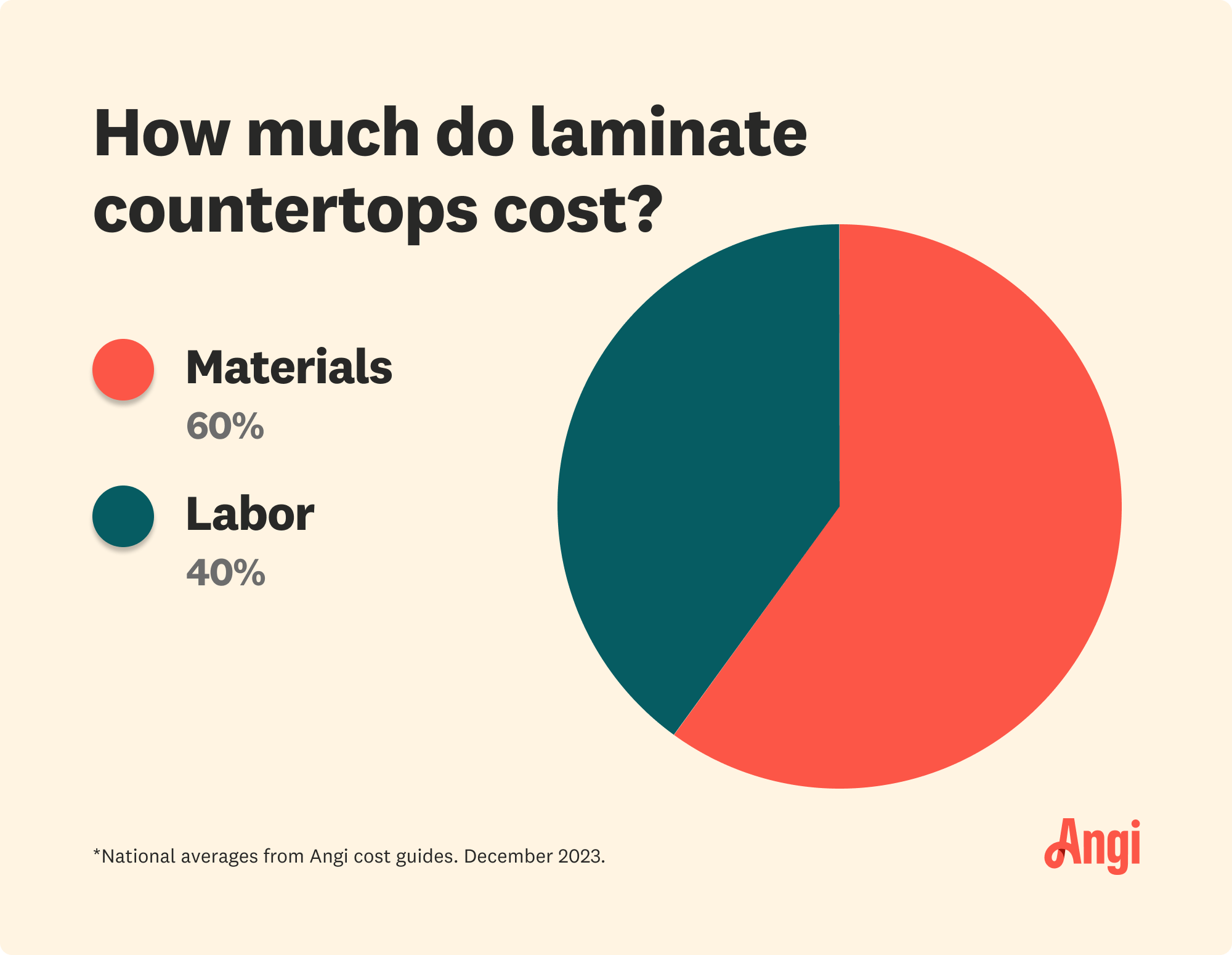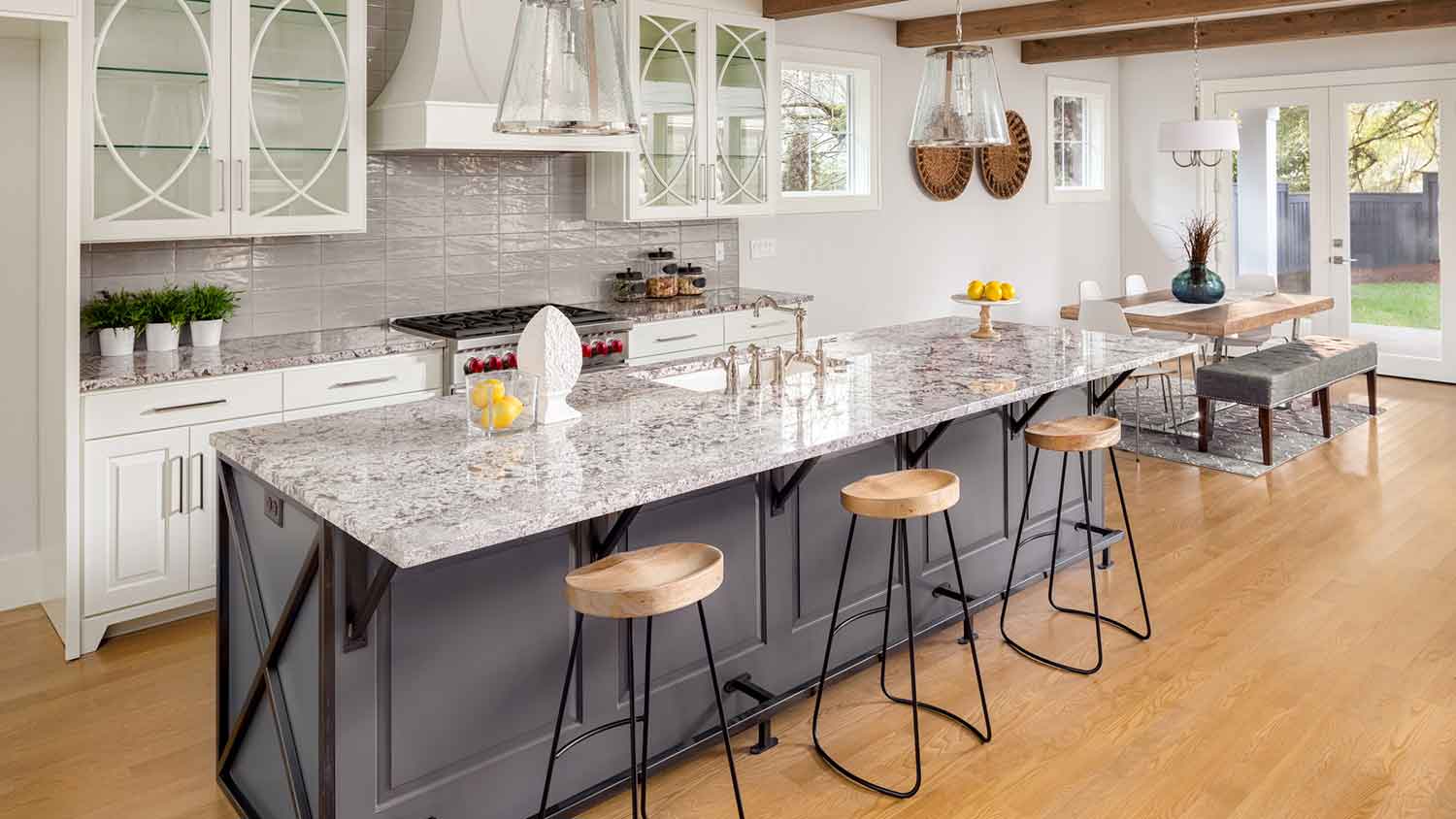
Kitchen islands are multipurpose workhorses in your kitchen. When looking to add one to your home, you should consider its size, materials, and its primary use in your home. Learn about the price of kitchen islands and their different features.
Say goodbye to prepping dinner on chipped and peeling countertops


Imagine inventing a countertop material so popular that homeowners associate the brand name with a whole category of countertops. Invented more than 100 years ago, Formica® is one of the most common laminates used on kitchen countertops for its durability and lower price tag.
Damage and wear and tear can occur over time, so it is good to know when to call in the pros and when to fix the countertop yourself. From chips and scratches to unsightly stains, use these five handy tips for laminate countertop repair.

When looking into laminate countertops pros and cons, one perk is that they are often easy to repair with store-bought repair kits. Most hardware stores carry a plastic laminate repair paste. The tube will set you back between $5 and $20, depending on the brand and the style of your countertop.
Laminate repair pastes are best for chips, holes, and scratches that only measure a few inches but stand out like a sore thumb. Maybe the dog leaped up and took out a piece of the countertop with its paws or perhaps an upright mixture cracked the Formica® after years of use. No matter how it happens, follow these guidelines for repairing the damage.
Formica® comes in a wide range of colors, so you will need to do a little sleuthing when picking the right paste color. Laminate paste makers know this, however, and they will likely provide a full array of common colors and instructions on how to mix hues to create your ideal color. If you are concerned about the match, request a custom paste color based on a sample of your counter.
Every brand of laminate paste comes with unique instructions, so be sure to follow the suggested steps. For example, some brands will advise you to clean off the area with an acetone-based cleaner before applying the paste.
After prepping the area, use a metal putty knife to spread the paste into the crack, scratch, or hole. Remember to remove any excess paste immediately after your first pass. Many pastes will dry in under an hour, so this is a quick process.
So, what are Formica® countertops? They consist of a combination of kraft paper, melamine resin, and a decorative topper in your desired style. Its makeup can cause Formica® to peel over time, especially around the edges of the counter and any surrounding areas that are prone to water damage.
If the layer of laminate separates from the countertop below but is not chipped, you will need to reglue it. Begin by lightly heating the old glue. Place a tea towel over the area and use an iron on a no-steam cotton setting. This process should loosen the area around the spot so you can gain access. Use a putty knife to clean the area of any debris or loose glue.
You will find a wide range of contact cement brands, including Gorilla Glue and 3M, but it is critical that you use one that is made specifically for laminate counters. Follow the manufacturer’s instructions and apply a thin, even layer of cement below the peeled area. Weigh down the spot with a book during the drying process.
Formica® countertops do not stain easily—one of the best perks of this affordable option. But stains do still happen, especially if they have sat for a while. The Formica® brand website recommends two options for getting rid of stains. Your first attempt should use a solvent liquid, such as ethanol, acetone, or rubbing alcohol. Rub the area in a circular motion with a soft clean rag, then rinse with water.
For tougher stains, create a paste with baking soda and water, then let the solution set into the stain before wiping it clean with water. Avoid rubbing the paste into the counter, as even light abrasion can damage the counter.
Let's say the days of repair paste and contact cement are long gone. A large portion of your Formica is in a state of major disrepair, but the rest of your countertop still looks new. Consider removing the entire damaged area and replacing it with a drop-in cutting board. This option is so popular that you will even find cutting board kits made for this purpose.
To start, measure the area around the damage with the provided template and use a jigsaw to delicately remove the countertop where the cutting board will go. A two-part drop-in kit typically includes a shallow stainless steel tray to insert into the countertop, as well as a cutting board to fit into the tray.

Much like a car, countertops reach a point of no return when they become too severely damaged to fix. It may be more cost effective in the long run to replace your countertops if they are heavily peeling, uneven, or scratched. Installation will cost between $30 and $40 per square foot for materials, and about $30 to $40 per hour for the team. Hire a laminate countertop installer near you and ask about pricing and suggestions for your project.
Looking to make an upgrade to a tougher countertop material? Consider the balance between cost, durability, and upkeep for materials like granite, quartz, marble, concrete, and wooden butcher blocks.

Here are some tips to help maintain your laminate countertop and avoid both minor and major countertop repairs.
Clean your laminate countertops with a little bit of dish soap and warm water. Use a soft brush or sponge and scrub the counter clean. Once you are done, wipe down the counter with warm water and pat dry with paper towels or a microfiber cloth. Avoid any harsh chemicals or abrasive cleaners to avoid accidentally damaging your counters during cleaning.
You can seal your painted laminate countertops with clear acrylic or polyurethane sealers. This will help protect your counters from scratches, peeling, chipping, and fading. Your counter will also have more heat and moisture resistance.
Additionally, you can breathe new life into old painted laminate countertops by applying a resin or epoxy sealer. For areas with moisture, go with epoxy over resin. These options allow you to apply a new layer on top that covers the original countertops below. For example, you can install an epoxy sealer that emulates marble.
If you hire a professional to tackle the problem, expect your laminate countertop repair to cost between $150 and $650. Factors that can impact the cost include the size, severity, and type of damage. If you need to replace a whole chunk of the countertop, you’ll pay quite a bit more than you would to repair scratches or peeling. Labor costs between $35 and $100 an hour, plus the cost of materials.
While it’s much cheaper to repair laminate countertops yourself, whether or not you should depends on your experience and the repairs required. Repairing scratches and small chips with a laminate repair paste is a simple job that will cost under $20 in materials. It’s similarly easy and inexpensive to reglue peeling laminate or clean it when stained.
On the other hand, replacing part of your countertop with a drop-in cutting board requires cutting a hole in the countertop with a jigsaw. Similarly, a small error in replacing laminate can leave the countertop susceptible to water damage. If you haven’t done this before, you’re better off hiring a professional to avoid further damaging the countertop.
Homeowners can repair their laminate countertops if the surface is still in relatively good shape except for minor damage, like small chips or lifting seams. In these instances, DIYers or a pro can easily camouflage or repair these issues using the appropriate materials.
Conversely, replacement is best if your countertop is water-damaged, swollen, deeply cracked, or significantly burned or chipped, especially around the seams and edges. All of the above are signs of significant damage compromising the structure. You may also want to consider replacing your counters if they are outdated or no longer fit your kitchen's design. In these cases, upgrading can improve both functionality and home value.
TERRIBLE COMPANY. Extremely rude people and the job was so sloppy. They ruined our walls and the countertops came damaged. They didn't care to help either. DO NOT USE
Mike did a great job. I did not want the standard tile backsplash. I picked a distressed porcelain floor tile which could be used as a kitchen backsplash and it came out perfect. Highly recommend.
Jack and his son did a phenomenal job with the work! We couldn't be happier. Jack stands by his work and will take care of any detail. The shiplap was put up seamlessly with precision on difficult cuts. The backsplash was done meticulously and added to the clean lines we were looking for. Due...
From the initial email I had sent to Bill until the completed professionally done tile backsplash in our kitchen, Bill and his team were consummate professionals. I received prompt calls and emails back addressing any questions I had and a meeting was quickly set up at a convenient time for...
Set in Stone was a pleasure to deal with. They carried a nice selection in the Level 1 granite (which is the category that I was interested in), and were very competitive on the pricing. I chose the Santa Cecilia Gold from the slabs in their yard. They included 2 D-shaped sinks in the price....
Anthony and his assistant,Tom, arrived as scheduled and took great care in their preparation for painting. Before doing the ceiling, wall shelves were carefully removed; coverings were placed over furniture, cabinets, countertops, appliances, floors -- everything. When finished, there was...
Fast, clean & very personable. Even brought me a spare sink to be hooked up when cabinets were installed so I would have a working sink when he measured for the countertops...Very accomadating, would definitely use them again
From average costs to expert advice, get all the answers you need to get your job done.

Kitchen islands are multipurpose workhorses in your kitchen. When looking to add one to your home, you should consider its size, materials, and its primary use in your home. Learn about the price of kitchen islands and their different features.

Are you leaning towards solid surface countertops? If so, you've likely come across Corian®. Find out how much Corian® countertops cost so you can plan your project.

Explore how much concrete countertops cost to install based on factors like their size, thickness, location, finish, and labor rates.

Installing countertops is grueling work, so leaving a tip for your countertop installers is always an appreciated gesture—but how much depends on the quality of work.

Knowing how to cut laminate countertops can help you save money on installation. Just make sure you have the right tools and experience.

If your countertops are getting old, dull, or showing signs of wear, it may be time to do something. But to refinish vs. replace countertops is the question.